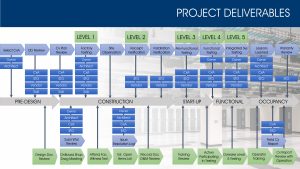The Importance of Comissioning
March 4, 2019
comissionIn the world of design and construction, “commissioning” can be a bit nebulous. Some people confuse it with quality assurance or control—and it is partly that. But commissioning is also validating the design to ensure what was built was installed correctly and operates properly. It’s also not the same for every situation. For instance, commissioning the systems of a building built to achieve LEED certification differs drastically from commissioning employed for a high-level data center. But in every case, it’s an important element of the design.

whatexactlyWhat exactly is it then?
nutshellIn a nut shell, commissioning is a process to verify that the design and function of a facility meets the owner’s expectations and requirements. Commissioning is an absolute requirement in many sectors. In healthcare, the commissioning process ensures that critical systems like air quality, life safety generators or medical equipment function as designed. In pharmaceutical or manufacturing facilities, commissioning could target the MEP and air handling systems of a laboratory or the entire processing line of a factory.
criticalsecctorIn the mission critical sector, commissioning is essential. It spans the entire timeline of construction, from kick-off through to turn over. At Structure Tone, our process for commissioning a data center typically includes these steps:

leveloneLevel 1.Factory witness testing to ensure the equipment ordered for the project meets all the proper specifications.
leveltwoLevel 2.
On-site verification of equipment when it’s delivered to make sure there is no damage.
levelthreeLevel 3.
Quality control/vendor start-up to not only ensure the systems were built and installed well, but that they function properly when up and running.
levelfourLevel 4.
Component testing of each component of every installed system to ensure they meet the design criteria established by the design team.
levelfiveLevel 5.
“Integrated system testing,” or IST, which involves essentially “pulling the plug” on electrical service to test the system and its components’ response to failure.
componentandsystemIn other words, rather than test a component or system at the end of a project, we test them all at each stage and, ultimately, take that testing a step further by forcing failure and assessing the effects so we can adjust the systems to be even stronger.
It takes a village
Given the comprehensive nature of this approach, it takes more than the contractor or the engineer alone to conduct proper commissioning. The entire project team plays a role:
agent
 Commissioning agent
Commissioning agent
seriousclientIf a client is serious about commissioning, they may want to hire a commissioning agent. This expert writes the step-by-step plan for testing and validation of all the building systems and conducts the tests when the time comes.
eeElectrical engineer
overcurrentThe engineer has, of course, designed a system for the building that should include overcurrent protection, safety protections, etc. Some owners allow the engineer to handle the commissioning of their own systems, but it’s generally advised to get the unbiased input of a third-party specialist.
meMechanical engineer
similareeSimilar to the electrical engineer, the mechanical engineer defines the sequence of operations of the system, the controls and other factors. Their input is critical to how the commissioning process moves forward, particularly if a problem arises.
ownertwoOwner
The owner has a role, too. They are the ultimate end users, so if any issue does arise during the commissioning process, owners may need to step in and make decisions on how the team should move forward.
managerConstruction manager
involvedcmIn an ideal world, the CM is involved in the commissioning process right from the start and functions, essentially, as the quarterback. The CM is intimately familiar with the design, responsible for the subcontractors and facilitating progress every step of the way. And if the commissioning process uncovers an issue—the CM is there to resolve it.
missioncriIn a mission critical facility, that kind of comprehensive involvement—and rigorous testing—is necessary. Failure is necessary. Because when a data center goes live, the owner and their clients must be 100% certain they can rely on the facility to protect their data no matter the circumstances. Commissioning provides that confidence, for the project team, the owner and the many users who trust in that security.
Based in Chicago, Ed Zemaitis is a Mission Critical account executive across the Structure Tone organization.
